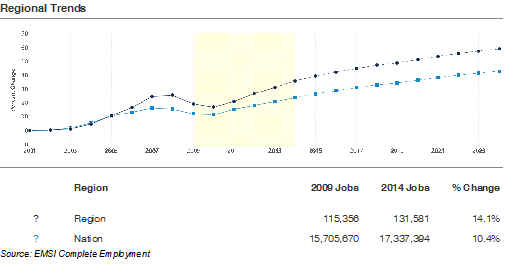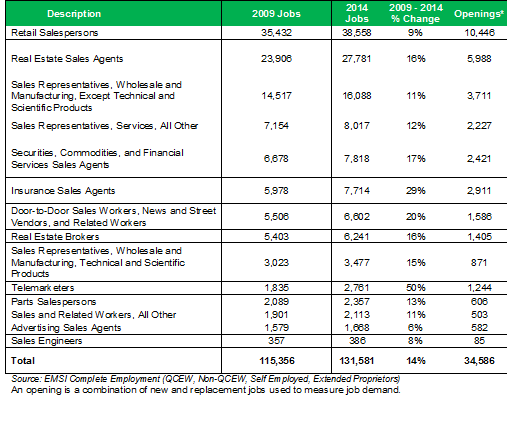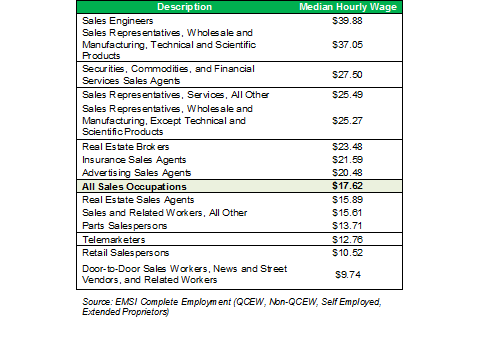
16 Jan Workforce by the Numbers: Sales occupations in the “new economy”
Charlotte Works is pleased to continue Workforce By The Numbers, spotlighting workforce research from around the region. Data and analysis are provided through our partnership with the Charlotte Chamber.
Sales jobs aren’t new; they’ve been greasing the wheels of the economy since the very beginning and are found in every company, across all industries.
A career in sales contains certain challenges: for starters, you have to sell things, and oftentimes serve as the front-line soldier of the company. On the other hand, if you enjoy interacting with the public, finding solutions for customers, aren’t looking for the typical “9-to-5” and have an entrepreneurial spirit, sales may be your calling.
Perhaps it’s time for a re-think of “Death of a Salesman.” After two decades of talk about the “new economy,” the death of brick and mortar stores and the entire world a “click” away, the data tells a completely different story. Consider these facts:
- Annual spending by U.S. companies on their sales efforts is three times the amount spent on all consumer advertising; more than 20 times what they spend on all online media; and more than 100 times what they spend on social media.
- $300 billion in online retail sales accounts for just six percent of total sales and is beginning to flatten out.
- From 2009 to 2014, the U.S. added 1.6 million sales jobs, outpacing the rest of the economy by more than four percent.
What does this mean to you?
Over the past five years, the region added 16,225 sales jobs, a growth rate of 14 percent.

The greatest demand is for retail salespeople, followed by real estate, technical, and securities.
Retail accounts for the largest sales occupation, capturing 38,558 of the 131,581 jobs.
Real estate is one of the occupation’s bright spots: real estate agents and brokers both grew by 16 percent. Real estate provides a great opportunity with relatively low barriers to entry. The region has a high concentration of real estate agents – 45 percent above the national average.
Surprisingly, telemarketers experienced the fastest growth at 50 percent.
The median hourly wage is $17.62 an hour, with wages ranging from $39.88 to $9.74 an hour.
Sales engineers, at the top of sales occupations, typically work for information technology and consulting firms. This position is essential to a successful sales team; think of the sales engineer as a quarterback, leading the team by providing technical expertise and key information to close the deal. It often requires specialized training and a four-year degree; 67 percent of the sales engineers in the region possess a bachelor’s degree or higher compared to retail sales, where 59 percent have a high-school diploma or some college.
While sales jobs offer unique challenges and may not be for the faint-of-heart, they’re far from a dead occupational tract. These jobs offer unique opportunities with a tremendous upside of earnings potential and relatively low barriers to entry. As with any occupation in today’s highly competitive economy, life-long learning and/or technical expertise help increase income. Long live the salesperson!

Paul E. Hendershot serves as director of research at the Charlotte Chamber of Commerce. Prior to joining the Charlotte Chamber team, he worked as manager of business development in the commercial real estate department at Dallas/Fort Worth International Airport (DFW) and spent four years as the research director at the Dallas Regional Chamber. During his tenure with the Chamber, Hendershot completed more than 100 unique economic development projects including Comerica, AT&T, Gulfstream, Arbitron, Capital One and Research in Motion. He is also founder and chief economist of Hendershot Economics, where he defined the life sciences industry for BIOCOM, among other projects in the Greater San Diego region.
Data included in this article is inclusive of North Carolina’s Southwest Region Prosperity Zone, which includes Anson, Cabarrus, Cleveland, Gaston, Iredell, Lincoln, Mecklenburg, Rowan, Stanly and Union counties.




